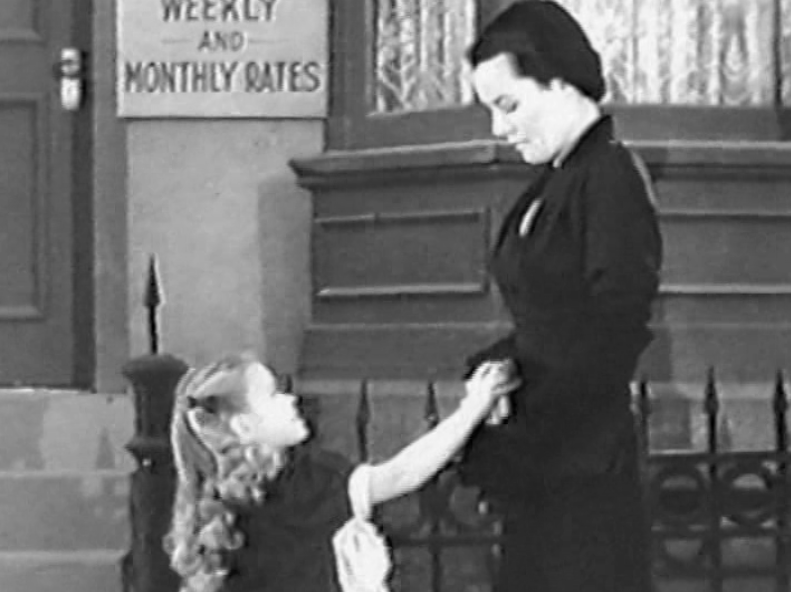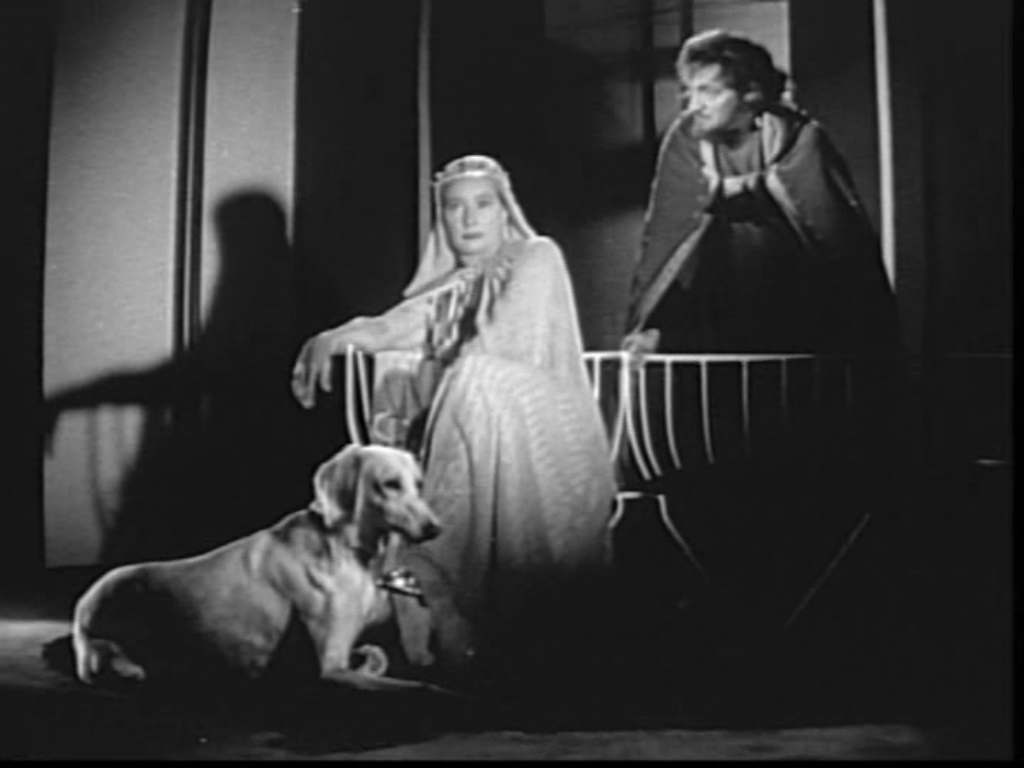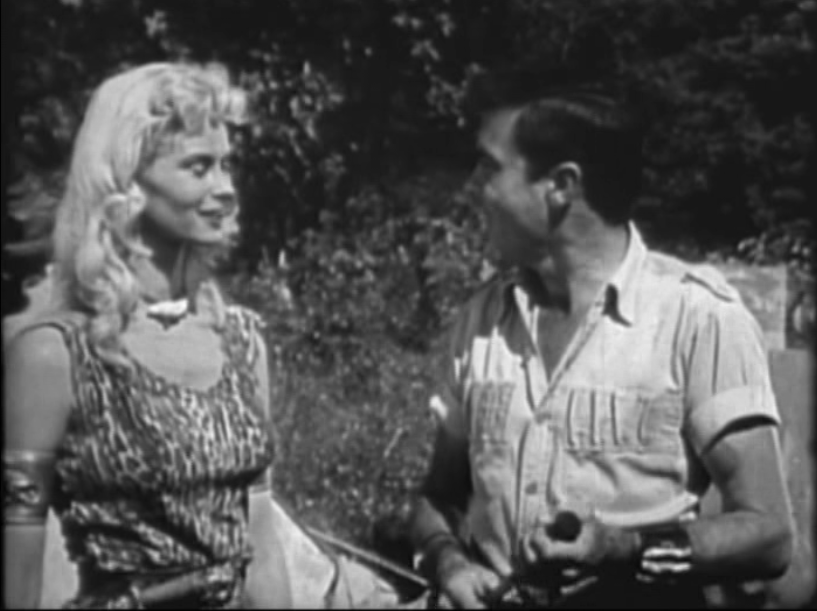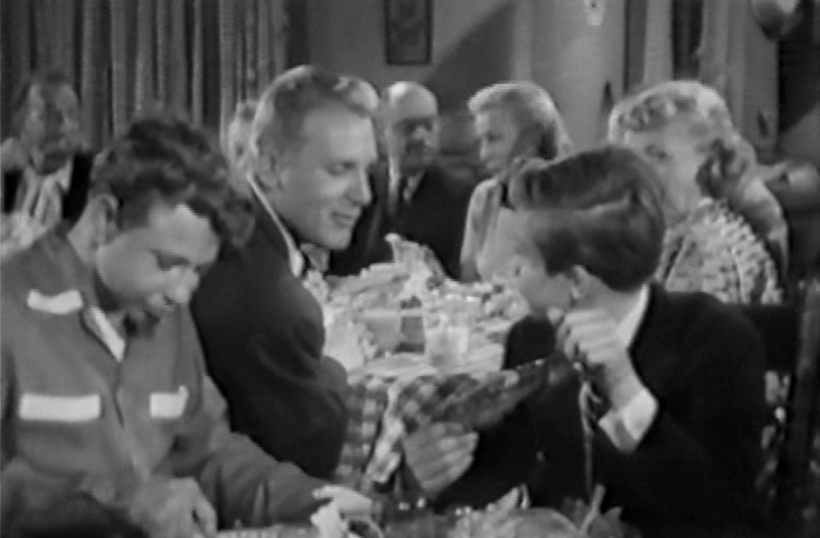TV Review: The Adventures of Dr. Fu Manchu | Flash Gordon | Sheena, Queen of the Jungle | The Joe Palooka Story
In my quest to watch all the DVDs I have purchased and never gotten around to, I have come to a collection of four random episodes from 1950s adventure television. Let’s see what we have in the grab bag!

“The Adventures of Dr. Fu Manchu” I have talked about before. Glen Gordon stars as the Devil Doctor, with Lester Matthews as his nemesis Sir Denis Nayland Smith and Clark Howat as Dr. Petrie, here a member of the Surgeon General’s staff. Laurette Luez is Fu Manchu’s right hand woman as Karamaneh (minus her function as Petrie’s love interest.)
In “The Plague of Dr. Fu Manchu”, our villain shows off why he’s got a doctorate with a virus that’s a masterpiece of bioengineering. It can only be spread by skin contact with a specially prepared human carrier, with the victims not being contagious. It attacks the nervous system, making the victim unable to speak or move to indicate how they got infected, and kills in exactly seven days. And the antidote not only destroys the virus but almost instantly repairs all the nerve damage.
Fu Manchu sends the Human Carrier into the big city, to randomly infect people of all classes and walks of life. She hesitates with her first victim, a small child, but after the child touches her anyway, the Human Carrier no longer relents.
The evil mastermind then sends his ransom demand. Give him a particular Pacific Ocean island, or he will infect another city, and another, until America is on its knees. This particular island is strategically vital, and giving it up will cause America to lose face with its Asian allies. But how many civilians is the government willing to sacrifice to keep that island?
As it turns out, the very fanatical devotion of the Human Carrier to Fu Manchu is the plan’s weak point. She loves her cruel master and sees Karamaneh as a rival. So the carrier lures Karamaneh into a trap and infects her. Since Karamaneh was carrying a vial of antidote at the time, some remains intact enough for Dr. Petrie to reverse engineer. Fu Manchu has to content himself with retrieving Karamaneh and punishing the Human Carrier with the fate of all failures.

“Flash Gordon” is an interesting American/West German/French co-production from 1954-55. Steve Holland played Flash, Irene Champlin was Dale Arden, and Dr. Hans Zarkov was portrayed by Joseph Nash. Most of the other actors were Germans, many of whom did not speak English and had to learn their lines phonetically.
In this version of the story, Flash and company are agents of the Galactic Bureau of Investigation. They jet through the galaxy in their ship, the Sky Flash, fighting tyrants and saboteurs. The series was shot on a shoestring budget, with a lot of reused sets and stock footage. Dale is more of an action woman in this timeline than the earlier adaptations, often filling in as a pilot or astrogator, as well as helping Flash in fights.
“Death in the Negative” opens with an explanation that most of the inhabited planets have specialized in one kind of trade good. There’s a grain planet, meat planet, smelting planet and so forth. And then there’s Cygnii. Its wasteful inhabitants have stripped the planet of its resources and destroyed its ecosystem. The other planets have been accepting Cygniian refugees as quickly as they can manage.
But then there’s the queen of Cygnii. A haughty and prideful woman, she has hogged what remains of the planet’s wealth to induce scientists to work on a secret plan for her. The Negativizor shuts out all helpful radiation, preventing photosynthesis and causing oxygen levels to plummet. (The special effect is that the scene appears in photographic negative; nifty and inexpensive!)
The queen demonstrates her new weapon on the Galactic Council and states her demands. New trade agreements where each other world exports half their resources to Cygnii in exchange for not dying. She’s less concerned with her citizens’ well-being than with having as many of them as possible under her control–something that wouldn’t apply to those settled on other, freer worlds.
Flash and friends have to find and destroy the Negativizor before the deadline the queen has set to get her way or kill the Council. The pivotal moment is when Dr. Zarkov realizes that the Negativizor ray itself is the best guide to the hidden “space island” it’s based on.

“Sheena, Queen of the Jungle” was loosely based on the comic book character of the same name. She’s the daughter of an American explorer who died in central Africa, and she was then raised by the natives. She has a simian sidekick named Chim and her love interest is the great white hunter (and in the TV show wildlife photographer) Bob. This was the breakout role for Irish McCalla, heroine to girls of the 1950s and pinup to the boys.
“The Magic Bag” has a native lad try to steal Bob’s camera, and then kill him. He either cannot or will not speak, but is from a tribe several days journey to the west in Kenya. Bob’s going that way on a safari to get baboon pictures, and Sheena pressures him into taking along the boy. She also finds him a head bearer who is elderly and limps, but has much local wisdom.
Along the way, the expedition runs into Dr. Becker, a Swiss physician who is looking for the source of a native remedy with strong healing properties. Bob, against his will, winds up taking him along too. Eventually, Bob and the others are captured by the boy’s tribe, but Chim tracks the boy down and saves the day. An exchange of knowledge between European and African doctors proves fruitful.
While Sheena doesn’t do a lot in this episode, she’s refreshingly independent for a female character in the 1950s and treats herself as an equal to the bemused Bob.

“The Joe Palooka Story” was based on the long-running and popular in its time comic strip about a morally upright heavyweight boxing champion. It starred Joe Kirkwood, Jr., who’d also played the fighter in several movies.
“Turkey for Terry” has a couple of wiseguy sports reporters who play a trick on Joe’s manager Knobby by giving him a fake turkey for Thanksgiving. Confirmed bachelor Knobby realizes he can’t eat this bird by himself, and gives it to Joe. Joe knows his girlfriend Ann has already prepared a turkey and all the fixings, so gives the still wrapped item to Terry, a fatherless, poverty-stricken boy he meets on the street. But since it’s a prank, the story is rapidly veering towards tragedy.
Bess, Terry’s mother, shows her own character quickly. When she learns that they (apparently) have a turkey for Thanksgiving, she immediately invites her equally impoverished neighbors to join the meal, and they in turn bring their own small luxuries to share.
There’s also a subplot about two neighborhood bullies who harass Terry and extend the story by lying to Joe about Terry’s whereabouts.
A bit of a subversion–there’s an unsecured gun in Terry’s apartment, and he takes it out the window, and oh lord what’s he going to do with the gun? But it turns out he just wants to hock it for enough money to get a turkey for his mother since the cruel joke disheartened her.
Of course, by the end, Joe has redeemed his good name by saving Terry from a frozen death, he and Ann have brought their own meal to share, and the reporters also contribute real food. Even the bullies have learned their lesson and are allowed at the feast. It’s a feel-good story and sometimes you want that warm fuzzy emotion at the end of a DVD.
Content note: Both Fu Manchu and Sheena rely on outdated ethnic stereotypes. The Fu Manchu episode has peril to a child. The Joe Palooka story has bullying. Parents watching with younger viewers might want to have conversations about the sort of thing that was considered okay in older media.
Overall, an interesting assortment of old television. You might still be able to get it from Alpha Home Entertainment.

